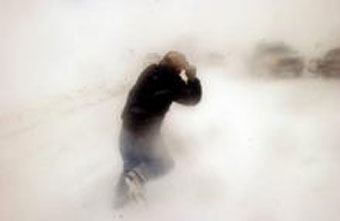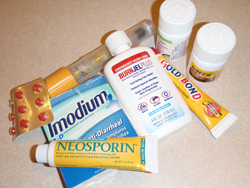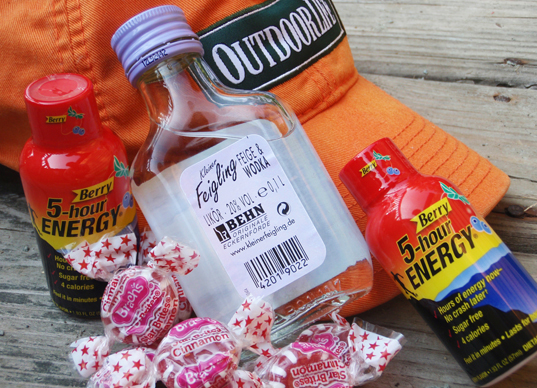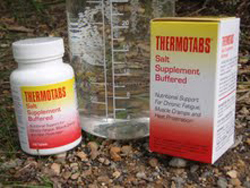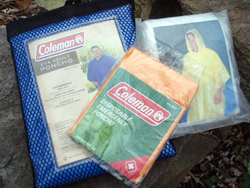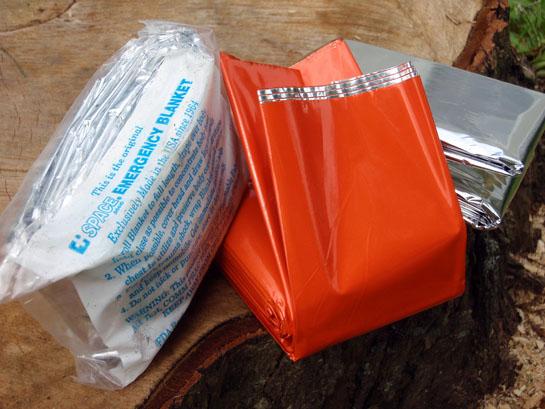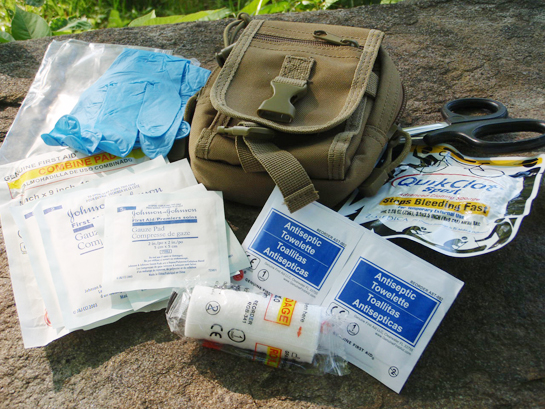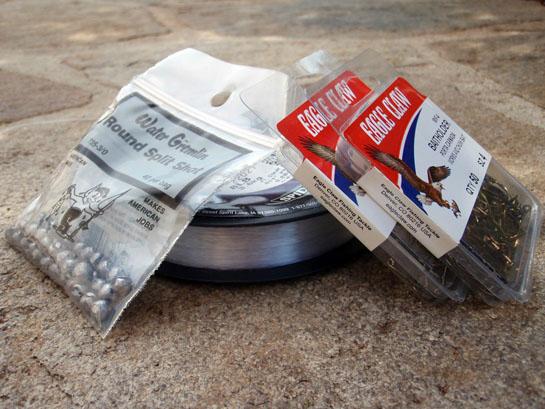We may earn revenue from the products available on this page and participate in affiliate programs. Learn More ›
An outdoorsman should have a basic survival kit that goes with him every time he heads into the wild. The kit should be as compact and lightweight as possible, without leaving out any of the essentials. Following are our recommendations for a basic kit and for additional gear you should carry when you go to the desert, mountains, ocean, tropics or arctic.
SHELTER
• Bivvy: One-person Emergency Bivvy by Adventure Medical Kits is windproof and waterproof, so crawl inside for protection against the elements. It reflects up to 90 percent of your radiated body heat, and also works as a signal panel.
• Reflective emergency blanket/tarp: Use this to double your protection. It works as a shelter half, a ground cloth or a personal wrap to retain body heat, and is extremely useful as protection against the heat of the sun. Some are available with silver on one side and a bright color on the reverse.
• Pocket poncho: Use as a poncho, a ground cloth, part of a shelter wall or roof, as a windbreak or as protection from precipitation. In some situations, it can be used as a water-collection device.
FIRE
• Lighter: Brunton Helios Stormproof. Windproof to 80 mph (according to the manufacturer), this adjustable and refillable lighter is carried by many back-country professionals and rescue teams. It will light when nothing else will.
• Fire starter: Blastmatch and Wet Fire accelerant from Survival Inc. The Blastmatch is a friction-type sparking device that creates monster sparks for igniting tinder. Wet Fire is a cube of highly flammable material that can be shaved into the tinder and will hold a flame even when wet.
SIGNALING
• PLB (personal locator beacon): ACR Terrafix 406 GPS I/O. When you absolutely need a rescue team to save your life, this is your ticket home. This PLB has an integrated GPS, so when you activate the unit it sends the distress signal along with your coordinates, which speeds rescue.
• Signal mirror: Safe Signal mirror by MPI Outdoors. The silver side is for daytime signaling; the red surface on the reverse side is for reflecting the beam of a flashlight at night.
• Signal whistle: Jet Scream by Survival Inc. This very durable, compact and lightweight whistle works even under water, so bad weather isn’t going to affect its function.
WATER PURIFICATION
• Sawyer SP130: Biological water filter with polycarbonate bottle. I like this unit because it is effective against giardia, cryptosporidia and more. There are no moving parts, no batteries, no chemicals, no waiting and nothing to fuss with. Just fill the bottle, insert the filter that’s connected to the top, screw it down and suck clean water through the flexible straw.
FOOD GATHERING
• Fishing line, hooks, sinkers, swivels: I keep an assortment of bait hooks and a few treble hooks, sinkers and swivels in a small film canister (an expedient float) and wrap the line around the container.
• Snare wire: Ten feet of lightweight wire can be used to set small-game snares on a trail.
MEDICAL
• Gauze 2×2s and 4×4s: For use as sterile dressings or compresses to stop bleeding.
• Roller bandage: To wrap a wound dressing or make a constricting band.
• Cravat: To make a sling, constricting band or tourniquet.
• Butterfly & other bandages
• Adhesive tape
• Tweezers
• Scalpel blade
• Alcohol wipes: To clean a wound or to start a fire.
• Hand sanitizer: Hygiene helps prevent disease, which can hinder your survival efforts.
• Toilet paper: For the obvious reason, and for starting a fire.
• Aspirin: General pain relief, and treatment for heart attack.
• Personal medications
NAVIGATION
• GPS and spare batteries: I carry a Garmin Geko 201, because it is small, lightweight and waterproof.
• Map of the area and a compass: Backup if the electronic stuff dies.
EQUIPMENT
• Multi-tool: Mine is a Leatherman Surge, but there are many good ones.
• Survival knife: A fixed-blade sheath knife heavy enough to use for chopping or prying.
• Small LED flashlight and spare batteries: I like lithium cells because of their exceptionally long shelf life. But they die without warning, so keep spares handy.
• Cordage: Fifty feet of 1/8-inch nylon twine or, better yet, 550 parachute cord. For help in constructing a shelter and many other uses.
• Metal cup: For cooking or catching water when using a solar still.
• Heavy-duty foil: Use this to form a container, for signaling or cooking, or as a fire reflector.
NOTES
• Keep the knife, multi-tool, GPS, fire starters and flashlight handy, so you don’t have to dig for them.
• Carry the poncho in a pocket, where you can get to it immediately if it starts to rain.
• If you’re carrying your kit in a pack, put all the tiny items in a small drawstring bag and stuff it into the metal cup.
• Put medical items in a separate drawstring bag of a different color, so they’re easy to locate.
Personal locator beacon Wet Fire Lighter Blastmatch Water-filtration bottle First-aid equipment GPS unit Fixed-blade survival knife Bivvy sack, poncho and space blanket Signal mirror Signal whistle LED flashlight Area map Compass Multi-tool Toilet paper Wire, fishing line, hooks and sinkers Metal cup, foil and paracord
Survival Kit Adaptations
Add these items to the basic kit, depending on where you’ll be.
FOR THE DESERT
• Solar still: A 6-foot by 6-foot sheet of lightweight plastic, and 6 feet of 3/8-inch plastic tubing
• Sunscreen: High SPF is best
• Polarized sunglasses
• Small shovel: To dig for water
• Wide-brimmed hat with neck shade
FOR THE MOUNTAINS
• Extra clothing
• Bug netting
• Insect repellent
FOR THE OCEAN
• PFD (personal flotation device): I like the manual/automatic inflatable harness type because it’s comfortable (which means I’ll wear it).
• EPIRB (emergency position-indicating radio beacon): The marine version of a PLB
• Parachute flares: Night-use signaling device
• Smoke flares: Day-use device
• Dye marker: Day-use device
• Personal strobe: Attach this to the shoulder of your PFD so it stays out of the water.
• Waterproof marine VHF radio
• Manual water maker
• Sunscreen
• Wide-brimmed hat with neck shade
• Polarized sunglasses
FOR THE TROPICS
• Sunscreen
• Polarized sunglasses
• Wide-brimmed hat with neck shade
• Bug netting
• Insect repellent
FOR THE ARCTIC
• Additional fire-starting methods: Carry a second lighter and a waterproof container filled with strike-anywhere wind/waterproof safety matches, such as the Pro-Force Survival Matches (available at lifeviewoutdoors.com/store/survivalgear). Also carry special fire starters, such as wax-soaked cotton balls you can buy or make yourself.
• Two-person Emergency Bivvy by Adventure Medical Kits: Use as a second layer over the one-person bivvy. Fill the space between the two with pine duff or other insulation to make a sleeping bag.
• Polarized sunglasses
• Avalanche shovel: For digging out or building a snow shelter

